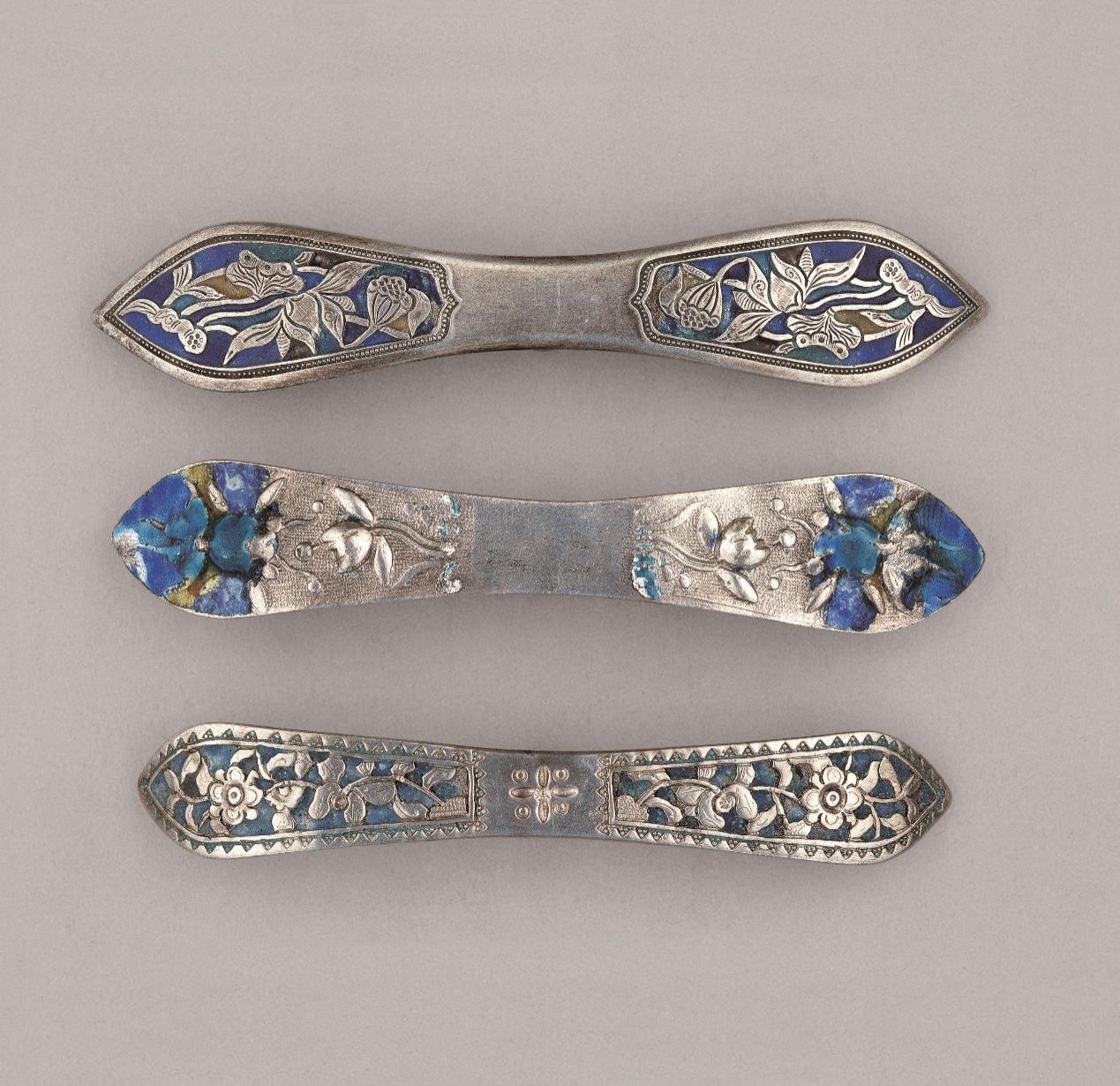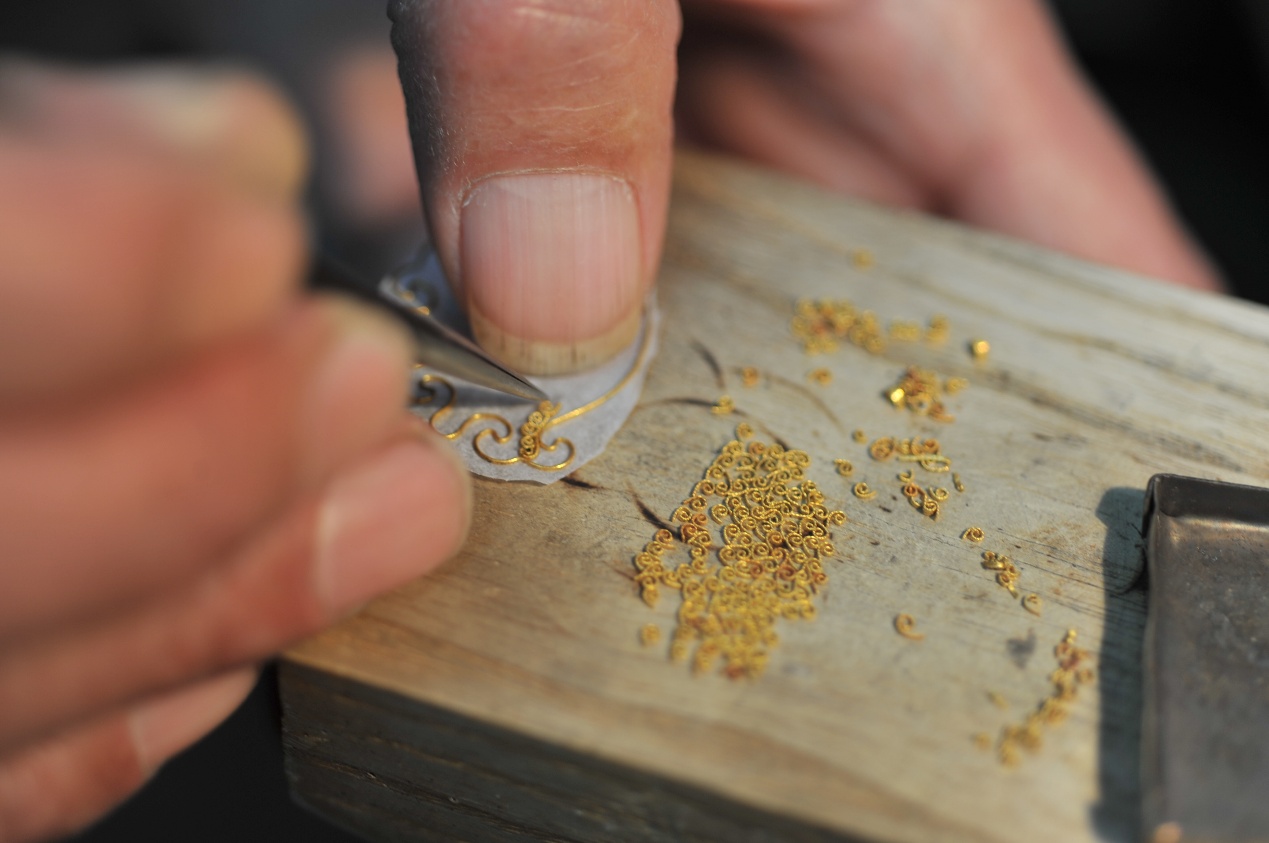Early jewelry consisted of simple gold sheet pieces shaped through hammering and beating techniques. As Central Plains civilization advanced, a variety of techniques gradually emerged, such as repoussé, filigree, granulation, kingfisher feather inlay, gemstone inlay, and enameling, each with its own emphasis depending on the period. For example, the repoussé technique involves fixing gold or silver sheets onto a glue board and using chisels of various shapes and sizes to engrave from both the front and back. Through repeated hammering and pressing, the artisan creates either flat or relief patterns. These motifs are often beloved by the public and express the Chinese people’s aspirations for a good life. Take hairpins as an example. In the Tang Dynasty, hairpins featured chrysanthemums and peonies, full of natural vitality. In the Song Dynasty, motifs such as manchi jiao (a poetic reference to lush lotus ponds) depicted mandarin ducks frolicking in water in lush lotus ponds, exuding subtle elegance and cultural refinement. In the Ming and Qing dynasties, hairpins adorned with pine, bamboo, plum blossoms, and chrysanthemums symbolized the highest spiritual pursuits, moral integrity, and philosophical ideals of the Chinese people.

Han Chinese repoussé hairpins
The filigree and granulation techniques were especially popular during the Han Dynasty. Granulation, also known as microbeading or millet-beading, involved a traditional process where a large basin was filled with cold water, and a stone was half-submerged in it. Molten gold was then splashed forcefully onto the stone; as the gold scattered and rapidly cooled in the water, it formed beads of varying sizes. These gold beads were then sorted by size using sieves. An example of this technique can be seen in the Tianlu Bixie (auspicious beast statues) unearthed from the Tomb of Liu Chang, King Mu of Zhongshan in the Eastern Han Dynasty. In these works, gold filigree was used to construct the structure of the beast bodies on three-dimensional gold sheets, the background densely soldered with gold granules and inlaid with turquoise and red agate. These pieces reflect the unique Han Dynasty aesthetic that combines grandeur with subtle elegance.

Filigree technique: shaping and filling with fine wires
The use of kingfisher feathers as decoration became fashionable starting from the Warring States period. As recorded in Han Feizi, the people of Chu crafted special wooden boxes to store their precious pearls: “The boxes were adorned with pearls and jade, decorated with roses, and inlaid with kingfisher feathers.” The Book of Han also notes that in the Zhaoyang Residence of Emperor Chengdi’s favored consort, the interior walls were decorated with luminous pearls and kingfisher feathers. The diancui technique (kingfisher feather inlay) involved using animal glue to affix kingfisher feathers onto gold or silver bases, or onto extremely thin leather sheets tanned from animal hide. The unique honeycomb structure within the feather barbs reflected light in such a way that the piece appeared to shift color,“one hue when viewed head-on, another from the side, a third under direct light, and yet another in shadow”, producing a vivid blue-green iridescence. Because of their complexity and the scarcity of kingfisher feathers, diancui ornaments were very expensive. In the late Qing Dynasty and the period of the Republic of China, many such adornments were replaced with shaolan (blue enameling), a type of cloisonné technique in which a blue glaze was applied to silver and then fired at high temperature. Today, diancui reemerges with a contemporary twist. Modern designers often substitute kingfisher feathers with materials like goose feathers, peacock feathers, and silk ribbons to create innovative decorative pieces.

Silver-gilt diancui hairpin inlaid with gems and symbols of blessing and longevity
With its long history and dazzling variety, traditional craftsmanship embodies the Chinese people’s understanding of beauty, carrying the ingenuity of generations of artisans. It has been passed down through time and continues to exert a profound influence. Today, the resurgence of “Guochao” (China-chic) and traditional aesthetics is brimming with vitality, “Chinese-style aesthetics” and “Chinese-style living” have become the new fashion. Many young people are embracing and learning traditional crafts, drawn to their individuality, creativity, and cultural warmth. Traditional craftsmanship shines with unique charm.
Every craft originates from the needs of daily life and evolves in response to the times. Only when it becomes part of everyday living can traditional craftsmanship sustain itself and thrive. Today, we must effectively draw from the cultural memory and national heritage embedded in these crafts, while embracing new technologies and creative concepts. With an open mindset, we can allow traditional craftsmanship to bridge past and present, function and beauty, preserving the warmth of the handmade and the human spirit behind it.
(The author is an associate professor at the Academy of Arts & Design, Tsinghua University.)

